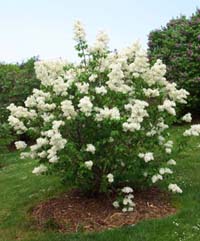Knowledgebase
Lilac dying one trunk at a time #555902
Asked April 25, 2019, 7:21 PM EDT
Nassau County New York
Expert Response
You may just need to your old lilac by pruning it back (you can find other information on the International Lilac Society:
How to Prune Lilac Bushes

For the absolutely perfectly shaped lilac bush, you need to prune them each year. Pruning lilac bushes is a very important part of growing and caring for Lilacs. While some varieties only grow 4 to 8 feet, others can reach up to 30 feet tall. Most Lilac bushes will grow in excess of 10 feet. Pruning not only helps with shape and appearance, but also helps to maintain good plant health and vigor, and the profusion of flowers.
There definitely is a right and a wrong way to prune a lilac bush. There is also a right and a wrong time. Most importantly, prune or trim back your bush immediately after they are done blooming. Remove the spent bloom along with the flower stem with your clippers. This will keep the plant from growing seeds, and encourage creation of next year's buds. Next year's flower bud develops very soon after the blooms have died off, even though you may not see it. Lilac buds form at the ends of the growing tips of the branches. I have seen inexperienced gardeners trim the tops several inches back. While the bush looked nicer, they loped off the next year's flowers with one pass of the hedge trimmer or pruning shears. We do not recommend using hedge trimmers. It gives a "too trimmed" appearance. Lilacs are not hedges. They are things of beauty.
General Pruning
Lilac bushes should be pruned and maintained each year.The plants should be full looking, yet not overly bushy. If the plant is too bushy, the inner leaves do not get enough sun and air circulation, an invitation to plant disease.
Trim larger stems from the center of the bush to increase ventilation. It allows more room for newer shoots on the outside of the plant to develop.
Pruning should be done immediately after the flowers have died off. Cut small suckers and shoots at or near ground level, or where it comes out of the main trunk. Leave a few strong and healthy new stalks each year, especially if you are planning to trim back old wood.
Trim back any branches that stick out from the main bush, and is not appealing to you.
Topping the bush is not recommended. A flat top is not an appealing lilac shape to most lilac lovers. A slightly rounded top looks best.
It is okay to clip off old, dead flowers and their stems at any time.
When trimming and pruning your Lilac bushes, beauty is the eyes of the beholder. If you like a tall bush, let it grow tall, If you prefer a wide bush, encourage shoots that have spread out from the main bush.

Trimming Mature Lilac Bushes
If a lilac bush has become overgrown, or is too large or tall for the area you have allotted it, there are a couple of ways to prune Lilacs.
We recommend the three year plan. A lilac shoot takes about three years before it produces a flower. So plan to eliminate 1/3 of the shrub each year, selecting the oldest stalks. Cut them down to just above the level of the soil. As you do, allow a new shoot to grow, to replace each old one you remove. By the end of three years, the entire shrub will have been replaced, and you will not go without lilacs for that period of time.
If life with your overgrown shrub has just become unbearable, remove all old stock and leave just new first or second year shoots. This is pretty drastic. And, you will go a couple of years with out lilac flowers. But Lilacs are hardy. As long as there are a few healthy new shoots, they will grow back.
Hope this is helpful.

